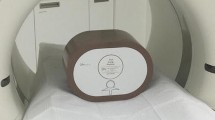Abstract
Purpose
This preliminary study compared ultrasonography-computed tomography (US-CT) fusion imaging and conventional ultrasonography (US) for accuracy and time required for target identification using a combination of real phantoms and sets of digitally modified computed tomography (CT) images (digital/real hybrid phantoms).
Methods
In this randomized prospective study, 27 spheres visible on B-mode US were placed at depths of 3.5, 8.5, and 13.5 cm (nine spheres each). All 27 spheres were digitally erased from the CT images, and a radiopaque sphere was digitally placed at each of the 27 locations to create 27 different sets of CT images. Twenty clinicians were instructed to identify the sphere target using US alone and fusion imaging. The accuracy of target identification of the two methods was compared using McNemar’s test. The mean time required for target identification and error distances were compared using paired t tests.
Results
At all three depths, target identification was more accurate and the mean time required for target identification was significantly less with US-CT fusion imaging than with US alone, and the mean error distances were also shorter with US-CT fusion imaging.
Conclusion
US-CT fusion imaging was superior to US alone in terms of accurate and rapid identification of target lesions.




Similar content being viewed by others
References
Sheafor DH, Paulson EK, Simmons CM, et al. Abdominal percutaneous interventional procedures: comparison of CT and US guidance. Radiology. 1998;207:705–10.
Hirooka M, Iuchi H, Kurose K, et al. Abdominal virtual ultrasonographic images reconstructed by multi-detector row helical computed tomography. Eur J Radiol. 2005;53:312–7.
Hirooka M, Iuchi H, Kumagi T, et al. Virtual sonographic radiofrequency ablation of hepatocellular carcinoma visualized on CT but not on conventional sonography. AJR Am J Roentgenol. 2006;186:S255–60.
Nakai M, Sato M, Sahara S, et al. Radiofrequency ablation assisted by real-time virtual sonography and CT for hepatocellular carcinoma undetectable by conventional sonography. Cardiovasc Intervent Radiol. 2009;32:62–9.
Hakime A, Deschamps F, De Carvalho EG, et al. Clinical evaluation of spatial accuracy of a fusion imaging technique combining previously acquired computed tomography and real-time ultrasound for imaging of liver metastases. Cardiovasc Intervent Radiol. 2011;34:338–44.
Krucker J, Xu S, Venkatesan A, et al. Clinical utility of real-time fusion guidance for biopsy and ablation. J Vasc Interv Radiol. 2011;22:515–24.
Lee MW, Rhim H, Cha DI, et al. Percutaneous radiofrequency ablation of hepatocellular carcinoma: fusion imaging guidance for management of lesions with poor conspicuity at conventional sonography. AJR Am J Roentgenol. 2012;198:1438–44.
Makino Y, Imai Y, Ohama H, et al. Ultrasonography fusion imaging system increases the chance of radiofrequency ablation for hepatocellular carcinoma with poor conspicuity on conventional ultrasonography. Oncology. 2013;84(Suppl 1):44–50.
Makino Y, Imai Y, Igura T, et al. Usefulness of the multimodality fusion imaging for the diagnosis and treatment of hepatocellular carcinoma. Dig Dis. 2012;30:580–7.
Kudo K, Sasaki M, Ogasawara K, et al. Difference in tracer delay-induced effect among deconvolution algorithms in CT perfusion analysis: quantitative evaluation with digital phantoms. Radiology. 2009;251:241–9.
Lee JY, Choi BI, Chung YE, et al. Clinical value of CT/MR-US fusion imaging for radiofrequency ablation of hepatic nodules. Eur J Radiol. 2012;81:2281–9.
Wein W, Brunke S, Khamene A, et al. Automatic CT-ultrasound registration for diagnostic imaging and image-guided intervention. Med Image Anal. 2008;12:577–85.
Mauri G, De Beni S, Forzoni L, et al. Virtual navigator automatic registration technology in abdominal application. Conference Proc IEEE Eng Med Biol Soc Ann Conf. 2014;2014:5570–4.
Kelley CM, Lindsay DS. Remembering mistaken for knowing: ease of retrieval as a basis for confidence in answers to general knowledge questions. J Mem Lang. 1993;32:1–24.
Toshikuni N, Shiroeda H, Ozaki K, et al. Advanced ultrasonography technologies to assess the effects of radiofrequency ablation on hepatocellular carcinoma. Radiol Oncol. 2013;47:224–9.
Author information
Authors and Affiliations
Corresponding author
Ethics declarations
Conflict of interest
Takeshi Soyama, Yusuke Sakuhara, Daisuke Abo, Jeff Wang, and Yu Hasegawa declare that they have no conflict of interest. Kohsuke Kudo reports grants from JSPS KAKENHI Grant-in-Aid for Scientific Research (B), personal fees from GE Healthcare, Hitachi Medical Systems, Philips Medical Systems, Siemens Medical Systems, Toshiba Medical Systems, Canon Marketing Japan, Bayer Healthcare, and Daiichi-Sankyo Healthcare, which are not related to the submitted work. Yoichi M. Ito reports grants from Nihon Medi-Physics Corporation, personal fees from Japan Tobacco Inc., and personal fees from Ono Pharmaceutical Co., Ltd., which are not related to the submitted work. Hiroki Shirato reports grants and non-financial support from Hitachi, Co., Ltd., personal fees from Mitsubishi Heavy Industry, grants from Hitachi Medico, grants from Varian Japan, and grants from Shimadzu, Co., Ltd., which are not related to the submitted work.
Ethical standards
This article does not contain any studies with human or animal subjects performed by any of the authors.
About this article
Cite this article
Soyama, T., Sakuhara, Y., Kudo, K. et al. Comparison of conventional ultrasonography and ultrasonography-computed tomography fusion imaging for target identification using digital/real hybrid phantoms: a preliminary study. J Med Ultrasonics 43, 327–335 (2016). https://doi.org/10.1007/s10396-016-0704-2
Received:
Accepted:
Published:
Issue Date:
DOI: https://doi.org/10.1007/s10396-016-0704-2




